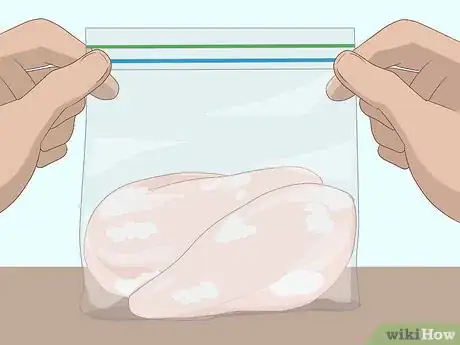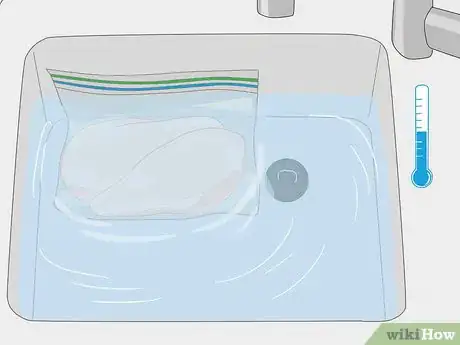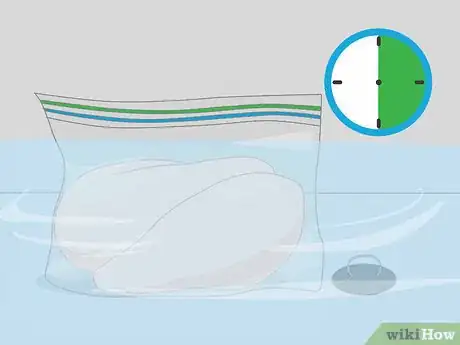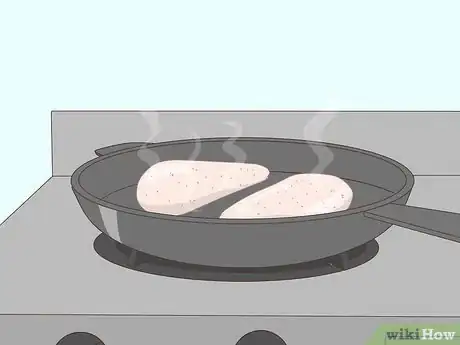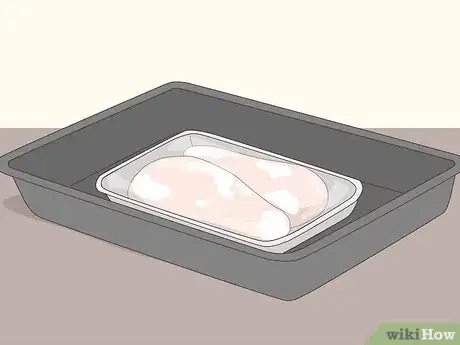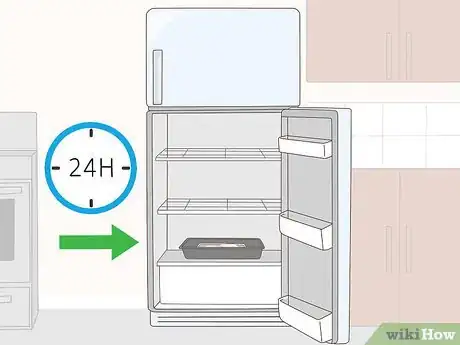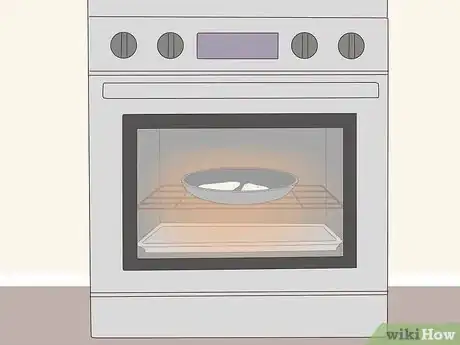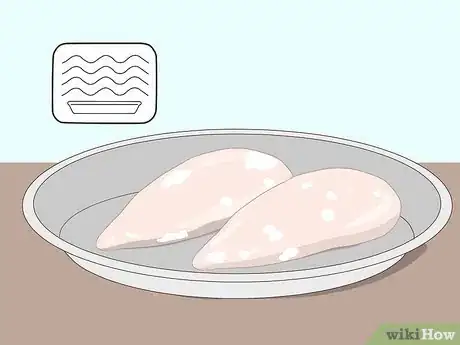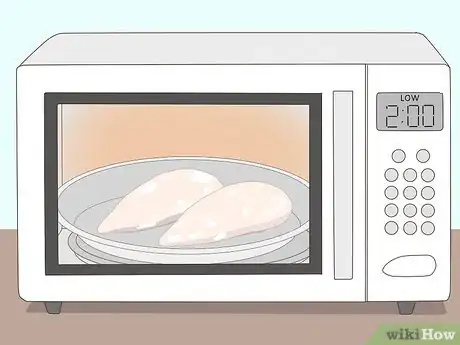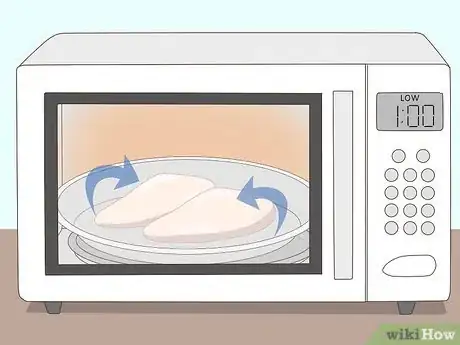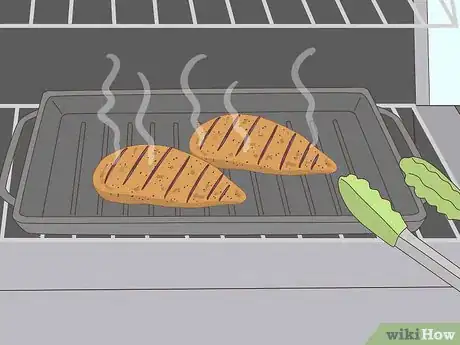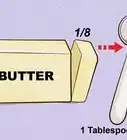This article was co-authored by Ollie George Cigliano and by wikiHow staff writer, Jessica Gibson. Ollie George Cigliano is a Private Chef, Food Educator, and Owner of Ollie George Cooks, based in Long Beach, California. With over 20 years of experience, she specializes in utilizing fresh, fun ingredients and mixing traditional and innovative cooking techniques. Ollie George holds a BA in Comparative Literature from The University of California, Berkeley, and a Nutrition and Healthy Living Certificate from eCornell University.
This article has been viewed 42,096 times.
If you have no idea what to make for dinner, start defrosting chicken breasts and by the time they're thawed, you'll have a plan ready. You can defrost chicken breasts in under an hour if you submerge them in cold water, but if you need a faster option, stick them in the microwave and use the defrost setting. Defrosting chicken breasts can also be flexible; if you're unsure when you want to cook them, just defrost them in the fridge and use them within a few days.
Steps
Thawing Chicken Breasts in Cold Water
-
1Transfer the frozen chicken breasts to a resealable bag. Take the chicken breasts out of their packaging and put them into a resealable plastic bag which won't leak. It's important to do this even if the chicken is in a Styrofoam tray that's covered with plastic.[1]
- Placing the chicken breasts into a bag will help the chicken defrost evenly without leaking juice in your kitchen.
-
2Put the bag of chicken into a sink and fill it with cold water. Push the plug in the sink and set the bag of chicken breasts into it. Turn on the tap and fill your sink with cold water. Try and submerge all of the bag so that all parts of the chicken breast will defrost at the same rate.[2]
- If you'd like to be able to use the sink while your chicken defrosts, put the chicken into a large bowl instead and fill the bowl with cold water.
Advertisement -
3Defrost the chicken breasts for 30 to 60 minutes. Leave the chicken breasts submerged in the water for 30 minutes. Then, check to see if they've defrosted. If they haven't, drain the water and submerge the chicken in fresh cold water. Leave the chicken breasts for another 30 minutes and check again.[3]
- If you're defrosting chicken breasts that still have the bones, they'll take about 10 to 15 minutes longer to defrost than boneless chicken.
Did You Know? It will take about 30 minutes to defrost 1 pound (450 g) of chicken breasts.
-
4Cook the defrosted chicken breasts immediately. Consider getting your oven, skillet, or grill ready while the chicken thaws so you can cook it right away. If you change your mind about cooking the defrosted chicken, you can put it back into the freezer.[4]
- Since you've warmed up the chicken breasts, you won't be able to store them in the refrigerator. Plan on cooking them right away to prevent bacteria from growing.
Defrosting Chicken Breasts in the Refrigerator
-
1Put the frozen chicken breasts on a dish. Keep the chicken breasts in their packaging and set the package on a plate or tray. Try to use a dish that has raised edges to catch any juice that might leak from the package as the chicken defrosts.[5]
- If you're defrosting individually wrapped chicken breasts, leave them in the packaging and place as many as you want to defrost on the dish.
- If you don't wish to use the packaging, for instance if it's damaged or you didn't get the chicken in packaging, then rest the chicken breasts on a plate lined with paper towels. Then cover in plastic wrap and place in the refrigerator.
-
2Refrigerate the chicken breasts for 24 hours. Put the dish of chicken breasts onto the bottom shelf of your refrigerator and leave them to thaw for a full day. As defrosting chicken in the refrigerator is a gentle method, there's no need to flip or move the chicken breasts as they defrost.[6]
- Keep in mind that if you're defrosting a block of chicken breasts that are frozen together, it may take an extra day.
Tip: Place a refrigerator thermometer into your fridge to ensure that it's set at 40 °F (4 °C) or lower.
-
3Cook the thawed chicken breasts within 2 days of defrosting them. You could cook the chicken breasts as soon as they're completely thawed or wait up to 2 days before cooking them.
- If you change your mind about cooking the chicken, you can keep it in the package and return it to the freezer.
Using a Microwave to Defrost Chicken Breasts
-
1Unwrap the chicken breasts and put them in a microwaveable dish. Throw away all the packaging and place the chicken breasts into a microwavable bowl or platter with raised sides.[7]
- Plan on thawing 1 to 2 chicken breasts at a time so you don't overcrowd the microwave.
- It's important to use a dish with sides so that it can catch juices from the defrosting chicken.
-
2Defrost the chicken breasts for 2 minutes at 30% power. Program your microwave so it's on a low power setting. Then, place the dish of frozen chicken breasts in it and defrost them for 2 minutes.[8]
- Don't worry if the chicken breasts are frozen together in a block at this point.
- If your microwave has a defrost button, you can press it and enter the weight of the chicken breasts. Your microwave should automatically alternate power levels as the chicken thaws.
- It is important to check the manual for your microwave to be certain as to its recommendations for thawing chicken. This will prevent accidentally starting to cook the chicken.
Did You Know? It will take about 5 to 6 minutes to defrost 1 pound (450 g) of chicken breasts in the microwave.
-
3Flip the breasts and defrost them for 1 more minute. Open the microwave and use tongs to flip each chicken breast over. Then, close the microwave and defrost the chicken for 1 minute to ensure they're completely thawed.[9]
- If the chicken breasts were frozen together, separate them now and turn them over.
-
4Remove the chicken breasts and cook them straight away. Although defrosting chicken in the microwave is convenient, it will cause some of the chicken to start cooking. Be prepared to cook the defrosted chicken breasts as soon as they're done in the microwave to prevent harmful bacteria from growing on the meat.[10]
- Avoid storing the defrosted chicken breasts in the refrigerator since you need to cook them immediately.
- If you're going to grill the chicken breasts, consider turning on or lighting the grill before you start defrosting the chicken.
Warnings
- Don't run cold water directly over frozen chicken breasts as this can spread bacteria through your kitchen.⧼thumbs_response⧽
- Avoid leaving chicken breasts on the counter at room temperature to thaw. Harmful bacteria can grow because the exterior will defrost faster than meat in the center of the breasts.[11]⧼thumbs_response⧽
Things You'll Need
Thawing Chicken Breasts in Cold Water
- Sealable plastic bag
- Sink or large bowl
Defrosting Chicken Breasts in the Refrigerator
- Plate or rimmed tray
- Refrigerator
Using a Microwave to Defrost Chicken Breasts
- Microwave
- Microwave-safe dish
References
- ↑ https://www.healthline.com/health/food-nutrition/how-to-defrost-chicken-the-safe-way#safe-ways-to-defrost
- ↑ https://www.fsis.usda.gov/wps/portal/fsis/topics/food-safety-education/get-answers/food-safety-fact-sheets/safe-food-handling/the-big-thaw-safe-defrosting-methods-for-consumers/CT_Index
- ↑ https://www.fsis.usda.gov/wps/portal/fsis/topics/food-safety-education/get-answers/food-safety-fact-sheets/safe-food-handling/the-big-thaw-safe-defrosting-methods-for-consumers/CT_Index
- ↑ https://www.stilltasty.com/articles/view/9
- ↑ https://www.fsis.usda.gov/wps/portal/fsis/topics/food-safety-education/get-answers/food-safety-fact-sheets/safe-food-handling/the-big-thaw-safe-defrosting-methods-for-consumers/CT_Index
- ↑ https://www.fsis.usda.gov/wps/portal/fsis/topics/food-safety-education/get-answers/food-safety-fact-sheets/safe-food-handling/the-big-thaw-safe-defrosting-methods-for-consumers/CT_Index
- ↑ https://www.bbcgoodfood.com/howto/guide/how-defrost-chicken
- ↑ https://www.epicurious.com/expert-advice/how-to-thaw-every-food-in-the-microwave-oven-article
- ↑ https://www.epicurious.com/expert-advice/how-to-thaw-every-food-in-the-microwave-oven-article
